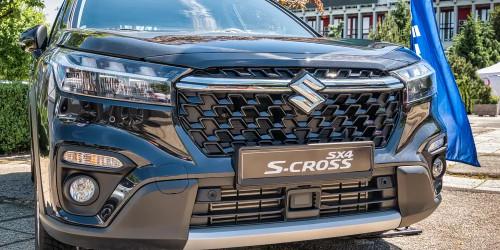
The Evolution of Suzuki: Bridging the Gap Between Economy and Luxury
Suzuki has transformed its budget-friendly image, incorporating premium features, hybrid technology, and global expansion. Models like the Grand Vitara and Swift Sport bridge affordability and luxury, redefining its role in the automotive industry.
Decades on, Suzuki remains a byword for affordability, reliability, and compact efficiency. But behind this pragmatic veneer is a changing legacy that has included the brand stepping outside its traditional adjacencies and into luxury. Long known primarily for building fuel-sipping hatchbacks, Suzuki has spent the subsequent decades marrying economy with refinement, making a name for itself in an industry firmly divided by a dichotomy: stripped-bare budget cars on one end and swelling luxury coupes on the other. As Suzuki has evolved from a low-cost commuter to a premium player, it's an interesting case study of how vehicles change with the brand.
Suzuki Start From The Bottom, Affordable Brands
Suzuki began as a loom manufacturer in 1909 and entered the auto industry in the 1950s. The Japanese economy needed affordable wheels in the post-war boom, and Suzuki responded in 1955 with its first mass-produced car, the Suzulight. The Suzulight was small, inexpensive, and thrifty, all traits that would define the brand for decades to come.
In the latter half of the 20th century, Suzuki established itself with vehicles famed for their price and utility, such as the Alto, Swift, and WagonR. The company appealed to urban commuters in search of inexpensive, efficient transportation. In the early 2000s, Suzuki became an internationally recognized industry leader in small car technology; Maruti Suzuki quickly established itself as the number-one automotive brand in India.
The Shift To Premium: A Strategic Change
Despite having made a lot of money, Suzuki started to notice a change in the market. Consumers were looking for more than just affordability; they wanted luxury, design sophistication, and tech. Enter Suzuki’s strategic shift. To cater to the upscale clientele, Suzuki launched the NEXA dealership network in 2015.
In an unexpected turn, Suzuki aimed for the high-end with launches such as the Suzuki Ciaz, Baleno, and Grand Vitara—cars intended to compete with luxury mid-market sedans and SUVs. These upscale offerings featured top-shelf materials, advanced infotainment systems, and Malaysian-style safety features, putting Suzuki in line with offs at the top of the market.
Suzuki Rental Cars and Global Expansion
Suzuki has built a reputation for producing economical and quality vehicles, further penetrating rentals and leasing services. As part of its global strategy, Suzuki rental cars are becoming an important part of the Suzuki business, with large rental companies incorporating Suzuki models into their networks. Their small size, fuel economy, and growing luxury features make them perfect for urban mobility solutions and the Suzuki rent a car business.
This expansion is generic to the mobility-as-a-service (MaaS) trend, which, in simple terms, means that instead of just manufacturing unemployment, automotive brands act as players in shared mobility ecosystems. Suzuki's entry-level range and ISR can attract budget-minded consumers as well as high-end callers in the higher game.
Technology Innovations and Electrification
Another major factor in Suzuki’s evolution was its technological developments. With several governments worldwide pressing towards stricter fuel efficiency and emission norms, Suzuki has had to adapt quickly. The company has also invested massively in hybrid & mild-hybrid tech and EVs. Suzuki's commitment to modern, eco-minded motoring is underlined by the arrival of its plug-in hybrid SUV, the Across.
In addition, Suzuki's collaboration with one of the world leaders in hybrid and electric technology catalyzes its premium and sustainable mobility strategy. So, Suzuki will trend toward, if not follow, consumer trends through Toyota's expertise in hybrid and electric car development. This means an electric Suzuki is not just a possibility but means Suzuki's future lineup will shift necessary to meet demand.
Competing with Luxury Brands
And though Suzuki may not yet be on a prestige level with the likes of Mercedes-Benz, BMW, or Audi, it has certainly forged a place where luxury meets affordability. Its combination of fuel economy, contemporary styling, and upscale appointments made it uniquely placed in the market. Examples of this not-so-subtle redefinition include the Suzuki XL6, Vitara Brezza, and Swift Sport.
Moreover, the introduction of Advanced Driver Assistance Systems (ADAS), luxuriously appointed cabin materials, and state-of-the-art infotainment display points towards Suzuki's effort to move upscale, as they also concentrate on the developing economies of India, Southeast Asia, and Africa.
An Overview of Industry Insights and Future Prospects
Market Positions
Suzuki has over 3 million units sold yearly, making it one of the top 10 car manufacturers worldwide. (Statista, 2023)
Consumer Trends
According to McKinsey & Company (2022) research, more than 65% of budget car customers seek quality features, a demand that Suzuki has fulfilled.
EV Growth
Suzuki is also very active in the global EV business, which is projected to grow at a 27% CAGR from 2023–2030 (BloombergNEF, 2023).
Armed with such insights, Suzuki’s interests advise your medium for upwardly mobile hunting—assuring your market share in the affordable segment while prudently climbing the luxury geosphere. As the world's automotive landscape continues to evolve with trends like sustainability, connected vehicles, and rental service models, Suzuki can position itself to be a major player.
Final Thoughts: A Fresh Start for Suzuki
Suzuki's evolution from producing cheap little cars to building an economy/premium mix. Suzuki is redefining its image with technology advancements, entry into luxury segments, and a large presence in rental fleets. The brand’s evolution has focused on the shifting needs of the modern consumer — one who craves affordability but won’t sacrifice comfort, tech, or style. It is a sign of good things to come, and as Suzuki rides this furious typhoon, it is a symbol of evolution in an ever-changing automotive universe.
